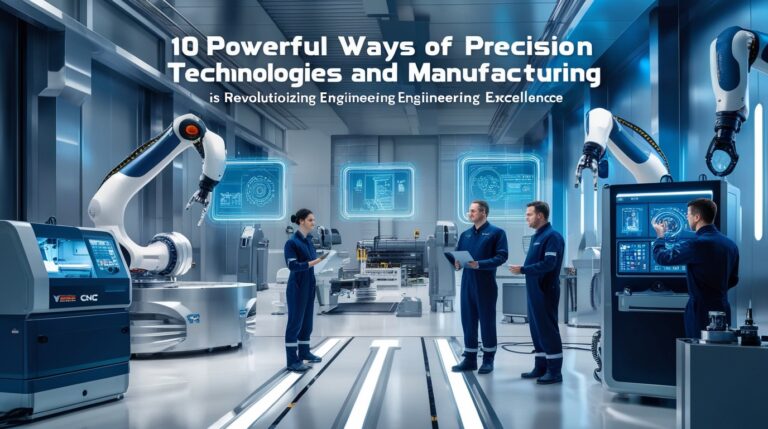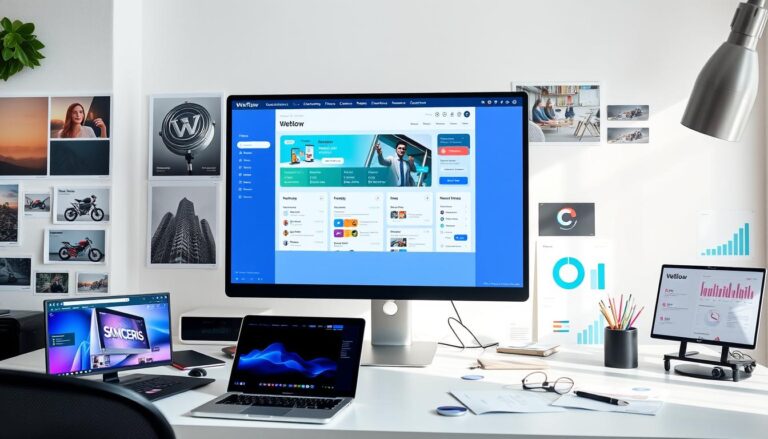2025 Tech Trends Shaping Business Growth and Innovation
Navigating the Digital Frontier: 2025 Tech Trends Shaping Business and Innovation
Estimated reading time: 13 minutes
Key Takeaways
- 2025 is driven by interconnected tech trends: AI automation, Next.js/React, Flutter/React Native, serverless cloud, and modern UI/UX are converging to reshape business operations and user experiences.
- AI is becoming pervasive and practical: From hyper-personalized web apps and customer service chatbots to internal workflow automation with tools like n8n, AI is delivering tangible efficiency gains and smarter SaaS features for businesses of all sizes.
- Performance and user experience are paramount: Fast-loading websites (Next.js, React performance fixes), intuitive mobile apps (Flutter, React Native), and accessible UI/UX design are crucial for engagement, SEO, and retaining competitive advantage.
- Cloud and DevOps enable agility and scalability: Serverless architectures offer cost-efficiency and automatic scalability for startups, while robust DevOps and CI/CD practices ensure rapid, reliable software delivery and modernization of legacy systems.
- Strategic digital transformation is key for growth: Businesses must embrace modular tech stacks, prioritize performance optimization, and strategically adopt innovations, even on a budget, to future-proof operations and unlock new levels of efficiency and customer satisfaction.
Table of Contents
- Introduction: The Accelerated Pace of Tech Transformation
- Core Pillars of Innovation in 2025
- Digital Transformation Strategies for Growth in 2025
- AITechScope: Your Partner in Navigating the 2025 Tech Landscape
- Conclusion: Embracing the Future of Technology
- Frequently Asked Questions (FAQs)
Introduction: The Accelerated Pace of Tech Transformation
The digital landscape is in a perpetual state of evolution, and 2025 promises to be a pivotal year, pushing the boundaries of what’s possible for businesses and consumers alike. We are witnessing an unprecedented acceleration in technological advancement, where innovations once confined to science fiction are rapidly becoming commonplace. From intelligent web experiences and versatile mobile applications to robust cloud infrastructures and pervasive AI automation, the tools and strategies available to companies are more powerful than ever.
This comprehensive guide serves as your essential playbook for understanding the 2025 tech trends that are not just changing how we interact with technology but fundamentally reshaping business operations and customer expectations. We’ll delve into the future of web development trends, explore breakthroughs in mobile app development 2025, examine the critical role of cloud computing and DevOps, illuminate the transformative power of AI automation for businesses, and highlight the imperatives of modern UI/UX design.
For business owners, developers, and tech enthusiasts, navigating this dynamic environment can be challenging. Our goal is to break down these complex trends into simple, actionable insights, demonstrating how today’s cutting-edge technology can accelerate growth, improve performance, and drive profound digital transformation. As a leading provider of virtual assistant services, specializing in AI-powered automation, n8n workflow development, and business process optimization, AITechScope is at the forefront of helping businesses leverage these intelligent solutions to scale operations, reduce costs, and achieve unparalleled efficiency. Join us as we explore the digital frontier and unlock the potential of 2025’s technological revolution.
Core Pillars of Innovation in 2025
The technological advancements in 2025 are not isolated phenomena but interconnected forces driving a holistic digital evolution. These core pillars – web development, mobile applications, cloud infrastructure, AI, and design – are converging to create more intelligent, efficient, and user-centric digital ecosystems.
Web Development: Building the Future of Online Experiences
The web remains the cornerstone of digital presence, but its capabilities are expanding dramatically. Web development trends for 2025 emphasize speed, intelligence, flexibility, and an unparalleled user experience.
The Rise of AI-Powered Web Apps
Artificial intelligence is no longer a backend utility; it’s becoming an integral part of the user-facing web experience. In 2025, expect to see a surge in AI-powered web apps that offer dynamic personalization, predictive analytics, and hyper-intelligent features. This means websites and web applications will be able to:
- Personalize Content at Scale: AI algorithms will analyze user behavior in real-time to deliver highly relevant content, product recommendations, and tailored interfaces. Imagine an e-commerce site that intuitively knows your preferences before you even search.
- Automate Customer Interactions: Advanced AI chatbots, powered by natural language processing (NLP), will handle a vast array of customer inquiries, providing instant support, guiding users through complex processes, and even assisting with sales. This elevates the customer journey and frees up human agents for more complex tasks.
- Enhance Accessibility and Inclusivity: AI can automatically adapt content for users with disabilities, translate languages on the fly, and even generate alt-text for images, making the web more inclusive.
- Drive Content Creation: AI tools, similar to ElevenLabs’ advancements in audio content, are beginning to assist with generating web copy, article summaries, and even basic visual elements, streamlining content pipelines. This makes your SaaS smarter with low-effort AI features that truly delight users by providing instant, relevant information or assistance.
Next.js and React: Performance, Scalability, and Developer Experience
For robust and high-performing web applications, React continues its dominance, with Next.js emerging as the go-to framework for production-grade websites. The emphasis in 2025 is on achieving lightning-fast loading times and seamless user interactions, crucial for both user satisfaction and SEO.
- Next.js for Small Business Sites: For small businesses needing a rapid, performant online presence, Next.js for small business sites is a game-changer. Its capabilities for server-side rendering (SSR), static site generation (SSG), and incremental static regeneration (ISR) ensure incredibly fast page loads, which is vital for search engine rankings and first impressions. A fast marketing site Next.js can be built efficiently, potentially in “one weekend,” providing a robust foundation for online marketing efforts without extensive development costs or time.
- Optimizing React Performance: Even with frameworks like Next.js, React performance fixes remain critical. Techniques like code splitting, lazy loading components, memoization, and efficient state management are essential to reduce page load times by “seconds,” directly impacting user retention and conversion rates. A real-world case study showed cutting page load by 60% for a client through focused optimization, underscoring its importance.
- Next.js Beginner Guide: The increasing adoption of Next.js means more resources and simpler entry points for developers. Its opinionated structure and comprehensive documentation make it an excellent choice for a Next.js beginner guide, allowing new developers to build high-quality web applications efficiently.
Headless CMS and WordPress: Flexible Content Delivery
The way content is managed and delivered is undergoing a significant shift. Headless CMS WordPress architecture is gaining traction, allowing developers to decouple the content management backend from the frontend presentation layer.
- Decoupling for Flexibility: This approach provides unparalleled flexibility, enabling content to be served across multiple platforms (web, mobile apps, IoT devices) from a single source. It allows developers to use modern frontend frameworks like Next.js or React while content editors continue to use the familiar WordPress interface.
- WordPress Without the Bloat: The perception of WordPress as “bloated” is being addressed through best practices and strategic plugin choices. Focusing on WordPress without the bloat means utilizing lightweight plugins that actually help SEO and choosing lean themes, ensuring that even traditional WordPress setups can compete in terms of speed and performance. This hybrid approach offers the best of both worlds: ease of content management and cutting-edge frontend capabilities.
Modern UI/UX Design: Intuitive, Responsive, and Accessible Experiences
User Interface (UI) and User Experience (UX) design are no longer afterthoughts but strategic imperatives. Modern UI/UX design in 2025 focuses on creating intuitive, responsive, and deeply accessible digital experiences.
- Responsive UI Design: With an ever-growing array of devices, responsive UI design is non-negotiable. Websites and applications must seamlessly adapt to various screen sizes, orientations, and input methods, providing a consistent and enjoyable experience whether on a desktop, tablet, or smartphone.
- Accessibility as a Priority: Inclusive design is moving from a nice-to-have to a must-have. Designing accessible buttons, navigation, and content ensures that everyone, regardless of ability, can interact with digital products. Resources like “Designing Accessible Buttons: A Non-Designer’s Guide (Figma Tips)” highlight the practical steps designers can take to achieve this, making digital products usable for a broader audience.
- Micro-interactions and Delight: Subtle animations, haptic feedback, and thoughtful micro-interactions contribute significantly to a positive user experience, making digital interfaces feel more natural and engaging.
Mobile App Development: Staying Ahead on Every Device
Mobile applications continue to be central to how businesses engage with their customers. Mobile app development 2025 is characterized by cross-platform efficiency, AI integration, and an expansion beyond traditional smartphones into a more ubiquitous computing environment.
Flutter vs. React Native in 2025: Making the Right Choice
The debate between Flutter and React Native for cross-platform mobile development remains vibrant, with both frameworks evolving rapidly. For startups and businesses, the decision hinges on specific project needs, team expertise, and long-term vision.
- Flutter’s Growing Maturity: Flutter, backed by Google, offers excellent performance often nearing native levels due to its compiled Dart code. Its widget-based UI system allows for highly custom and visually consistent apps across platforms, often with a smoother developer experience. It’s an excellent choice for businesses prioritizing bespoke UIs and rapid prototyping. “Build a Simple Cross-Platform App with Flutter: From Idea to Play Store” demonstrates its ease of use for new projects.
- React Native’s Ecosystem and Flexibility: React Native, leveraging JavaScript and the vast React ecosystem, benefits from a massive community and extensive libraries. Its “learn once, write anywhere” approach allows web developers to transition to mobile with relative ease. While sometimes facing performance debates compared to Flutter, continuous improvements mean it remains a powerful contender, especially for teams already familiar with React.
- Which Mobile Framework for Startups? For startups, the choice between React Native vs Flutter 2025 often comes down to available talent pool, desired time-to-market, and the need for specific native functionalities. Both frameworks are capable of building robust and scalable applications, and careful consideration of development costs, maintenance, and future scalability will guide the decision.
AI and Personalized Mobile Experiences
AI integration in mobile apps is moving beyond basic chatbots to create deeply personalized and adaptive experiences. This includes:
- Proactive Assistance: Apps will anticipate user needs, offering suggestions, automating tasks, and providing relevant information before being explicitly asked.
- Context-Aware Interactions: Leveraging device sensors and user data, apps will adapt their behavior based on context – location, time of day, user activity – to deliver hyper-relevant features and content.
- Voice AI Integration: Following trends like ElevenLabs expanding into audiobooks, expect more advanced voice AI capabilities directly within mobile apps, enabling natural language interactions, voice commands, and even AI-generated audio summaries or content delivery.
Beyond the Phone: Wearables and Ubiquitous Computing
Mobile app development is increasingly extending beyond smartphones to encompass a broader ecosystem of connected devices.
- Smart Glasses and Wearables: The emergence of devices like AI smart glasses, which can listen and record conversations, highlights a trend towards “always-on” AI integrated into our daily lives. While raising significant privacy concerns, these devices signal a future where digital interactions are more seamlessly interwoven with the physical world.
- Internet of Things (IoT) Integration: Mobile apps will increasingly serve as control centers for smart homes, connected cars, and various IoT devices, providing a unified interface for managing our increasingly connected environments. Mobile app UI trends will adapt to these diverse form factors, focusing on glanceable information and intuitive controls.
Cloud Computing and DevOps: Driving Efficiency and Scale
The backbone of modern digital operations lies in robust, scalable, and efficient infrastructure. Cloud computing and DevOps practices are essential for delivering agile, resilient, and cost-effective digital solutions.
Serverless Architecture: Cost-Efficiency and Scalability for Startups
Serverless computing is rapidly becoming the default choice for new applications and microservices, especially for startups and small teams.
- Pay-Per-Use Model: The “serverless AWS cost example” demonstrates the fundamental benefit: you only pay for the compute resources consumed, eliminating idle server costs. This makes it incredibly cost-efficient for applications with variable traffic patterns or those just starting.
- Scalability Out-of-the-Box: Serverless platforms automatically scale to meet demand, removing the operational overhead of managing servers. This allows a serverless backend for startups to handle sudden spikes in traffic without manual intervention, a huge advantage for rapid growth.
- Focus on Code, Not Infrastructure: Developers can focus entirely on writing business logic, abstracting away server management, patching, and scaling. This accelerates development cycles and reduces operational burden.
Cloud Migration Strategies: Modernizing Legacy Systems
Many businesses still rely on legacy applications hosted on on-premise infrastructure. Cloud migration strategy in 2025 focuses on practical, phased approaches to modernize these systems without disruption.
- “Lift and Shift” with Optimization: While a straightforward “lift and shift” can be a starting point, successful migration involves optimizing applications for the cloud environment post-migration. This includes refactoring for cloud-native services, leveraging managed databases, and implementing auto-scaling.
- Phased Modernization: The playbook “How to Move Your Legacy App to the Cloud Without Breaking It” emphasizes a phased approach, migrating components incrementally, and testing thoroughly at each stage. This minimizes risk and allows for continuous operation.
- Digital Transformation on a Budget: For small companies, digital transformation on a budget is achievable through strategic cloud adoption. Migrating to the cloud can reduce CapEx, lower operational costs, and provide access to advanced services without large upfront investments.
DevOps Best Practices and CI/CD Automation for Small Teams
DevOps methodologies and robust Continuous Integration/Continuous Deployment (CI/CD) pipelines are non-negotiable for rapid, reliable software delivery.
- CI/CD for Small Teams: For small teams, CI/CD for small teams is about automating repetitive tasks to free up developers for innovation. This includes automated testing, code quality checks, and deployment processes, significantly reducing manual errors and accelerating releases.
- GitHub Actions Deploy Tutorial: Tools like GitHub Actions make setting up CI/CD automation accessible and efficient. A “GitHub Actions deploy tutorial” can show how to automate deployments directly from code repositories to cloud platforms like AWS, ensuring that every code change is tested and deployed with confidence. This helps achieve “automated deployments without the headache.”
- Microservices Architecture: While not universally applicable, microservices architecture offers benefits in terms of scalability, resilience, and independent deployment for complex applications. However, understanding “Micro Frontends: When They Help and When They Hurt (Practical Examples)” is crucial to avoid unnecessary complexity. For small teams, starting with a modular monolith or well-defined services might be more appropriate before committing to a full microservices approach.
AI Automation: Empowering Businesses Through Intelligence
Artificial intelligence is transcending hype to become a fundamental driver of efficiency, innovation, and competitive advantage. AI automation for businesses is revolutionizing every facet of operations.
Chatbot Automation and AI for Customer Service
Chatbots have evolved beyond rule-based scripts to sophisticated AI-powered conversational agents.
- Enhanced Customer Experience: AI chatbots for customer service can provide instant, 24/7 support, answer frequently asked questions, resolve common issues, and even process orders. This significantly improves customer satisfaction by reducing wait times and providing consistent information.
- Operational Efficiency: By handling a large volume of routine inquiries, chatbots free up human customer service agents to focus on complex, high-value interactions. “How Small Businesses Use Chatbots to Save Time: Real Workflows That Work” showcases practical applications, saving businesses significant time and resources.
- Proactive Engagement: Advanced chatbots can proactively engage with customers based on their behavior or historical data, offering personalized assistance or product recommendations.
Workflow Automation Tools and n8n Development
The true power of AI in business often lies in automating internal processes. Workflow automation tools are central to this transformation.
- Automating Repetitive Tasks: Businesses can “Automate Repetitive Tasks with No-Code Tools + AI” to “Save 5-10 Hours/Week” per employee. This includes tasks like data entry, report generation, email management, lead qualification, and social media scheduling.
- n8n Workflow Development: AITechScope specializes in n8n workflow development, a powerful open-source tool that allows businesses to connect various applications and automate complex workflows with minimal coding. This empowers companies to build custom integrations and automation sequences tailored to their unique needs.
- Enterprise Digital Adoption: For larger organizations, workflow automation facilitates enterprise digital adoption by streamlining processes across departments, improving data flow, and ensuring consistent execution of tasks. This is a critical component of any successful digital transformation strategy.
Making SaaS Smarter: Low-Effort AI Features
Even small additions of AI can significantly enhance Software-as-a-Service (SaaS) products, creating delightful user experiences and competitive differentiation.
- “Make Your SaaS Smarter: 3 Low-Effort AI Features That Delight Users”: Examples include:
- Intelligent Search: AI-powered search functions that understand intent, correct typos, and provide more relevant results.
- Automated Summarization: Tools that can quickly summarize long documents or conversations. (Think ElevenLabs for text).
- Proactive Recommendations: Suggesting next steps or relevant actions based on user activity.
- AI-Powered Web Apps (Reiterated): The integration of these intelligent features directly into web applications creates a more intuitive and helpful user environment, blurring the lines between static content and dynamic, adaptive experiences.
Ethical AI and Data Privacy in an “Always-On” World
As AI becomes more ubiquitous, especially with devices like “always-on” AI smart glasses that listen and record, ethical considerations and data privacy become paramount.
- Transparency and Consent: Businesses leveraging AI must be transparent about data collection and usage, ensuring explicit user consent.
- Bias Mitigation: Efforts to identify and mitigate algorithmic bias are crucial to ensure fair and equitable outcomes.
- Security and Governance: Robust security measures and clear data governance policies are essential to protect sensitive information in an increasingly data-driven, AI-powered environment. The “Why I’m Not Using NotebookLM’s ‘Deep Research’ Tool (and Why You Shouldn’t Either)” discussion highlights the importance of critically evaluating AI tools and understanding their limitations and potential ethical pitfalls.
Modern UI/UX Design: Crafting Seamless Digital Journeys
User experience is the ultimate differentiator in the crowded digital marketplace. Modern UI/UX design in 2025 is about more than aesthetics; it’s about crafting deeply intuitive, efficient, and emotionally resonant digital journeys.
User-Centric Design Principles for 2025
The core of modern design revolves around understanding and empathizing with the user.
- Emphasize Accessibility and Inclusivity: As discussed in web development, accessible design is fundamental. This means considering diverse user needs, from visual impairments to cognitive differences, ensuring that interfaces are perceivable, operable, understandable, and robust for everyone.
- Personalization and Adaptive Interfaces: Beyond simple customization, interfaces will dynamically adapt to individual user preferences, behavior patterns, and context, providing a truly unique and relevant experience for each interaction.
- Emotional Design: Creating interfaces that not only function well but also evoke positive emotions, building trust and loyalty through delightful interactions and thoughtful design elements.
The Role of AI in UI/UX Research and Personalization
AI is becoming a powerful ally for designers, revolutionizing how user research is conducted and how interfaces are personalized.
- AI-Driven Insights for Design: AI tools can analyze vast amounts of user data, providing designers with deeper insights into user behavior, pain points, and preferences than traditional methods. This data can inform design decisions, leading to more effective and user-friendly interfaces.
- Dynamic Interfaces: AI can enable interfaces to dynamically adjust elements, layouts, and content in real-time based on user interaction, context, and even emotional cues, moving beyond static designs to truly adaptive experiences.
- A/B Testing and Optimization: AI-powered tools can automate and optimize A/B testing, rapidly identifying the most effective design variations and continuously improving user experience. This allows for continuous performance optimization techniques in UI/UX.
Digital Transformation Strategies for Growth in 2025
Digital transformation isn’t a one-time project but a continuous journey of adapting technology to meet evolving business needs and market demands. In 2025, successful strategies will hinge on agility, a focus on performance, and a future-proof tech stack.
Tech Innovation for Small Businesses and Startups
Small businesses and startups often face budget constraints but possess the agility to rapidly adopt new technologies. Tech innovation for small businesses is about strategic, impactful implementations.
- Digital Transformation on a Budget: As highlighted in “Digital Transformation on a Budget: 7 Steps Small Companies Can Start Today”, strategic cloud adoption, leveraging cost-effective SaaS tools, and implementing AI automation for repetitive tasks are key. AITechScope helps in guiding startups through these initial steps, identifying high-impact areas for digital adoption without overspending.
- Leveraging Open-Source and Low-Code/No-Code Tools: Tools like n8n, combined with AI, offer powerful capabilities without the need for extensive custom development, making sophisticated automation accessible.
- Focus on Core Business Value: Prioritizing technologies that directly impact revenue generation, customer satisfaction, or significant cost reduction ensures a strong ROI for tech investments.
Performance Optimization Techniques: Speed as a Competitive Edge
In an age of instant gratification, speed is paramount. Websites and applications must load quickly and respond instantly to maintain user engagement and competitive advantage.
- Real-World Case Study: Cutting Page Load by 60%: A testament to the impact of optimization, a focused effort on frontend and backend efficiencies can dramatically improve performance. This includes optimizing images, minifying code, leveraging CDNs, and efficient database queries.
- 5 Simple React Performance Fixes: Specific techniques like using
React.memofor memoization,useCallbackanduseMemohooks, virtualizing long lists, code splitting withReact.lazy, and optimizing state updates can significantly “reduce page load by seconds,” directly enhancing user experience and SEO. - Beyond the Frontend: Performance optimization extends to the server-side and database, ensuring that the entire tech stack operates efficiently. Performance optimization techniques should be integrated throughout the development lifecycle, not just as a post-launch fix.
Building a Future-Proof Tech Stack for Modern Businesses
A robust and adaptable tech stack for modern businesses in 2025 is characterized by flexibility, scalability, and integration capabilities.
- Modular Architecture: Embracing microservices or a modular monolith allows components to be updated, scaled, or replaced independently, preventing vendor lock-in and fostering agility.
- Cloud-Native First: Designing applications to leverage the inherent strengths of cloud platforms – elasticity, managed services, and serverless options – ensures scalability and resilience.
- API-First Approach: Building APIs for all services facilitates seamless integration with other systems, partners, and future technologies, enabling rapid innovation.
- Data-Driven Decisions: Implementing analytics and business intelligence tools to gather insights from operational data is crucial for informed decision-making and continuous improvement.
Enterprise Digital Adoption: Overcoming Challenges
While digital transformation is exciting, large enterprises face unique challenges in adopting new technologies, including legacy systems, cultural resistance, and complex internal processes.
- Strategic Change Management: Successful enterprise digital adoption requires a clear vision, strong leadership, and effective communication to manage the human element of change.
- Phased Rollouts and Pilot Programs: Implementing new technologies in stages, starting with pilot programs, allows for testing, gathering feedback, and iteratively refining processes before a broader rollout.
- Integration with Legacy Systems: Developing robust integration strategies for new cloud-native applications with existing legacy systems is critical to avoid data silos and ensure continuity of operations. This often involves API gateways, middleware, and data synchronization solutions.
- Upskilling and Reskilling Workforce: Investing in training programs to equip employees with the skills needed to utilize new tools and technologies effectively is paramount for maximizing adoption and ROI.
AITechScope: Your Partner in Navigating the 2025 Tech Landscape
At AITechScope, we understand that leveraging the 2025 tech trends for your business isn’t just about adopting new tools; it’s about strategic implementation that delivers tangible results. We are dedicated to empowering businesses, from nimble startups to growing enterprises, to thrive in this rapidly evolving digital era.
As a leading provider of virtual assistant services, AITechScope specializes in harnessing the power of AI-powered automation to streamline your operations. We excel in n8n workflow development, creating intelligent, interconnected systems that automate repetitive tasks, synchronize data across platforms, and optimize complex business processes. Our expertise in business process optimization ensures that your technology investments translate directly into increased efficiency, reduced operational costs, and enhanced productivity.
Whether you’re looking to integrate AI chatbots for superior customer service, build a lightning-fast marketing site with Next.js, migrate your infrastructure to a cost-efficient serverless cloud backend, or simply automate mundane workflows to save countless hours per week, AITechScope is your trusted partner. We break down complex tech challenges into simple, actionable solutions, helping you scale operations intelligently and prepare your business for the future. With AITechScope, you’re not just adopting technology; you’re transforming your potential.
Conclusion: Embracing the Future of Technology
The year 2025 stands as a testament to humanity’s relentless pursuit of innovation, offering a digital landscape brimming with unprecedented opportunities. We’ve explored the dynamic shifts across web development trends, with AI-powered apps and Next.js leading the charge for speed and intelligence. We’ve delved into mobile app development 2025, weighing the strengths of Flutter and React Native while recognizing the advent of ubiquitous, AI-integrated devices. Our journey through cloud computing and DevOps highlighted the indispensable roles of serverless architectures and CI/CD automation in fostering efficiency and scalability. Furthermore, the transformative potential of AI automation for businesses to revolutionize customer service and internal workflows is undeniable, albeit with a crucial emphasis on ethical considerations. Finally, modern UI/UX design remains the compass guiding these innovations toward truly user-centric, accessible, and delightful digital experiences.
For businesses of all sizes, embracing these 2025 tech trends is not merely an option but a strategic imperative for sustained growth and competitiveness. From startups leveraging Next.js for small business sites and serverless backend for startups to enterprises pursuing comprehensive digital transformation strategies, the path forward involves intelligent adoption, continuous optimization, and a willingness to innovate.
The future is here, and it’s intelligent, interconnected, and incredibly fast. By understanding these trends and strategically integrating them into your operations, you can unlock new levels of efficiency, enhance customer engagement, and drive unprecedented success. Partner with experts like AITechScope to navigate this exciting digital frontier, transforming complex technological advancements into clear, actionable advantages for your business. The time to build for tomorrow is now.
Frequently Asked Questions (FAQs)
Q1: What are the top tech trends for businesses in 2025?
A1: The leading tech trends for businesses in 2025 include widespread AI automation across all sectors, advanced web development with frameworks like Next.js for performance, continued growth of cross-platform mobile app development (Flutter/React Native), robust cloud computing with serverless architectures, and a strong focus on modern, accessible UI/UX design for all digital products.
Q2: How can small businesses leverage AI automation effectively?
A2: Small businesses can leverage AI automation by integrating AI chatbots for instant customer service, using workflow automation tools (like n8n) to automate repetitive administrative tasks (e.g., data entry, lead qualification), and incorporating low-effort AI features into their websites or SaaS products for enhanced personalization and efficiency, saving significant time and resources.
Q3: Is Next.js a good choice for building a fast marketing site for a small business?
A3: Absolutely. Next.js is an excellent choice for a fast marketing site for small businesses due to its superior performance capabilities, including server-side rendering (SSR) and static site generation (SSG). These features ensure lightning-fast page loads, which significantly improves user experience, boosts SEO rankings, and helps capture visitor attention quickly, providing a strong online presence.
Q4: Which is better for mobile app development in 2025: Flutter or React Native?
A4: Both Flutter and React Native are strong contenders for mobile app development in 2025, and the “better” choice depends on specific project needs. Flutter offers excellent performance and custom UI capabilities, ideal for visually rich apps, while React Native leverages JavaScript, making it suitable for teams familiar with web development and seeking a vast ecosystem. Startups should consider team expertise, required features, and long-term scalability.
Q5: How can AITechScope help my business with digital transformation in 2025?
A5: AITechScope helps businesses navigate 2025 tech trends by providing specialized virtual assistant services, AI-powered automation, and n8n workflow development. We assist in optimizing business processes, integrating cutting-edge AI tools for tasks like customer service and workflow automation, and building efficient digital solutions that reduce costs, improve efficiency, and accelerate growth, ensuring your business stays competitive and future-ready.







